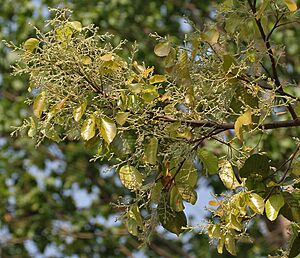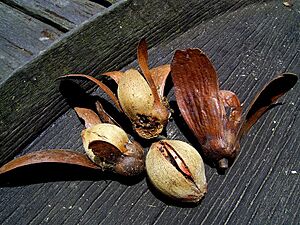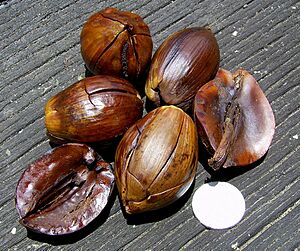Shorea robusta seed oil facts for kids
Shorea robusta seed oil is a special kind of oil that comes from the seeds of the Shorea robusta tree. This tree is also known as the Sal tree, and it grows naturally in India. You can find Sal trees in two main areas of India, separated by the Gangetic Plain. The Sal tree belongs to a plant family called Dipterocarpaceae.
Contents
What is the Sal Tree Like?
The Sal tree is a deciduous tree, which means it loses its leaves every year. These trees can grow very tall, sometimes up to 50 meters (about 164 feet)! Their trunks can be as wide as 5 meters (about 16 feet) around. Usually, they are between 18 to 32 meters tall.
The tree has a straight, round trunk and a wide, round top part called a crown. Its bark is dark brown and thick, which helps protect it from fires. When the tree is young, it grows a very long taproot that goes deep into the ground.
Where Sal Trees Grow
Sal trees like to grow in places that are between 100 to 1500 meters (about 330 to 4900 feet) above sea level. They need warm temperatures, usually between 22 and 27 degrees Celsius (72-81°F), but they can handle up to 47 degrees Celsius (117°F). They also need a lot of rain, from 1000 to 3000 millimeters (about 39-118 inches) each year.
The best soil for Sal trees is deep, well-drained, and a little bit sandy or clayey. They don't like to sit in water, so good drainage is important.
Leaves, Flowers, and Fruits
The leaves of the Sal tree are shiny and oval-shaped, about 10 to 25 centimeters (4-10 inches) long. When they first grow, they are reddish, but they soon turn a lovely green.
The flowers are yellowish-white and grow in big bunches.
The fruits are about 1.3 to 1.5 centimeters (0.5-0.6 inches) long. They have five wings that help them fly away from the tree when they ripen, usually in May. Inside the fruit, there's a kernel that contains about 14-15% fat. This kernel is what we use to get the oil!
How is Sal Oil Collected and Made?
Collecting Sal seeds is a very important way for many people living in forests in central India to earn a living. States like Odisha, Chhattisgarh, and Madhya Pradesh have huge Sal forests. Millions of people depend on collecting Sal seeds, leaves, and resins.
It's super important to store the seeds correctly after they are collected. If they get too wet, the oil inside can get damaged and become less useful.
There are a few ways to get the oil from the seeds:
- Traditional way: People used to get the fat out by using water.
- Machines: Today, machines like oil expellers and rotary mills can press the seeds to get the oil.
- Solvent extraction: This method uses special liquids (solvents) to pull the oil out of the seeds after they've been flattened into flakes.
What is Sal Oil Like?
When the oil is first taken out, it's a greenish-brown color and has a special smell. Because it has a lot of saturated fats, it's solid at room temperature. This is why it's often called Sal fat or Sal butter.
After it's cleaned up (refined), Sal oil can be used for cooking. It has a lot of stearic acid (a type of fat) and oleic acid (another type of fat). Refined Sal oil can even be used instead of cocoa butter in making chocolate!
What is Sal Oil Used For?
Sal oil, or Sal butter, is used in many ways:
- Cooking: People in the areas where it grows use it for cooking.
- Soap: It can be used to make soap.
- Chocolate: The refined and changed fat is a good substitute for cocoa butter in making sweets and chocolates.
- Other products: Sal butter is also used to make ghee (a type of clarified butter), paints, pigments, lubricants, and even oil for cars.





